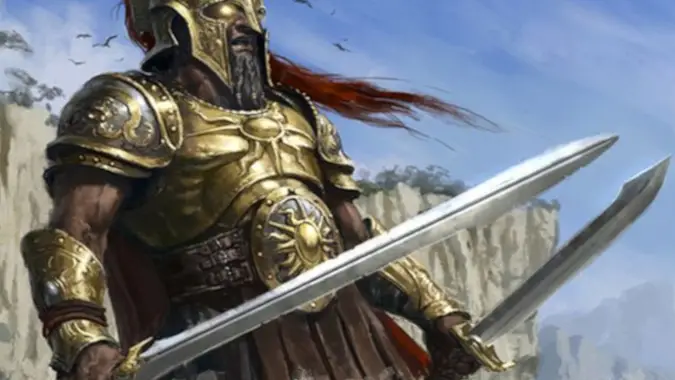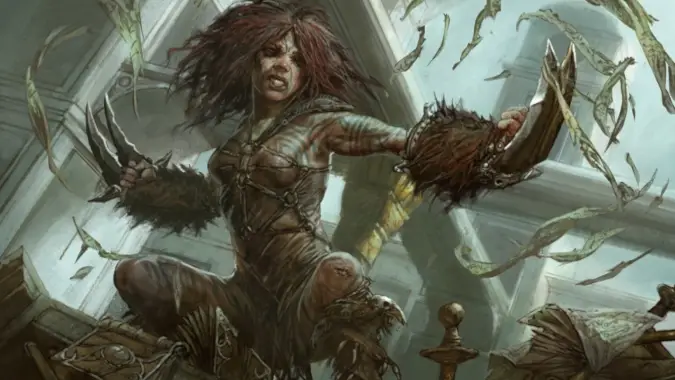The latest One D&D playtest introduces changes to how weapons work, including new Weapon Mastery

The latest One D&D playtest document has a host of changes to how weapons are going to work in the game’s next version, which is slated to come out next year to celebrate the 50th anniversary of Dungeons and Dragons.
It’s a pretty sizable playtest, with new rules for the Barbarian, Fighter, Sorcerer, Wizard, and Warlock classes. It also makes several changes to how weapons function in D&D and introduces a new kind of weapon quality called the weapon’s Mastery property. Access to a weapon’s Mastery is limited to classes that have the Weapon Mastery class feature, which are the Barbarian and Fighter classes right now.

How weapons are changing in One D&D
- Light weapons, like Daggers and Shortswords, now allow you to make an extra attack with a Light weapon in your offhand if you have a Light weapon in your main hand, as a Bonus Action.
- Thrown weapons are now drawn as part of the attack. So you don’t have to have your Handaxe or Throwing Dagger in you hand before you can throw it — you will yank it out and throw it all as part of the attack action when using a Thrown weapon. Also, if the Thrown weapon also has the Finesse quality, you can add your Strength or your Dexterity to the weapon’s bonus damage.
- Nets are no longer considered weapons, since they do no damage. They’re now regular adventuring equipment. You can still replace an attack action with a use of a Net to attempt to disable a target, who must make a Dexterity saving throw against a Difficulty of 8 + your Proficiency Bonus + your Dexterity modifier. So if you had an 18 Dex and were a 2nd level Rogue, your target would have to beat 8 + 2 +4 = 14 or higher on their Dex save, or be Restrained by your net. Once Restrained, it’s a DC10 Strength check to escape, or they can attack the net — AC10, 5HP, and immune to Bludgeoning, Poison and Psychic damage because it’s a net, you can’t make it sad or scared — and once it’s destroyed they’re free.
- Tridents got buffed. They now do 1d8 instead of 1d6 damage, and when used with two hands (their Versatility weapon quality) they deal 1d10 instead of 1d8.
- Lances are now Heavy and Two Handed weapons instead of having the Special weapon quality (which means they’re not given Disadvantage on attacks when you’re not on a horse anymore) and deal 1d10 instead of 1d12 damage. They still have Reach, and you can still use them with one hand if you’re Mounted.
- The Pistol and Musket have been added to the basic weapon table instead of being a Dungeon Master’s Guide only option.

What is Weapon Mastery in Dungeons and Dragons, and how does it work?
All weapons on the weapon table have a Mastery property in addition to their other properties like Light, Two-Handed, Versatile, and so on. Unlike those other weapons, a weapon’s Mastery property only applies to someone who has the Weapon Mastery class feature and has chosen that weapon as one they have mastered. Both Barbarians and Fighters have Weapon Mastery. As you might expect, Fighters gain more options with Weapon Mastery due to their Weapon Expert and Weapon Adept features, but these merely modify the Weapon Mastery options, they don’t alter them. There’s also the Weapon Master feat — it allows you to learn the Mastery property of one weapon and to change which weapon you have Mastery with on a long rest, so it’s a limited version of the class feature.
And yes, your Barbarian or Fighter could take that feat and get an extra weapon’s Mastery if they wanted to. At present, Barbarians top out at knowing the Mastery of up to four weapons and Fighters do so at five, so taking the feat would actually increase the Masteries they knew to 5 and 6 — not a bad use of a Feat considering it also gives a +1 to Str or Dex. And of course there could be uses for it for other characters, like that Rogue that would take it to get Vex on their daggers for more Sneak Attack opportunities.
The Weapon Mastery properties change the way a weapon can be used in combat and add more variety to how your attacks work. Each Mastery property has pre-requisites that will affect whether or not it can be used with features such as the Fighter’s Weapon Expert or Weapon Adept class features.
- Cleave — Melee weapon, Heavy property: Lets you hit an extra target within 5 feet of your first target when you make an attack. So if you’re a Barbarian who knows the Greataxe Weapon Mastery, you can hit that poor fellow directly in front of you, and if he has a buddy next to him, you can also roll an attack against that guy as well. Your Cleave attack does not get the benefit of your Strength damage bonus unless it’s negative.
- Flex — Versatile property: Lets you use a Versatile weapon like a Longsword as if you’re using it with two hands even when you’re only using it in one. So your Longsword will hit for 1d10 damage instead of 1d8 even when you’re only using it in one hand.
- Graze — Melee weapon, Heavy property: Lets you still deal some damage when you miss on an attack. You can inflict your Strength or Dexterity (whichever one applies) damage modifier as damage even when you miss a target. You can only increase this damage by increasing your damage modifier — so if you go from an 18 to a 20 Strength your Graze damage goes from 4 to 5 damage.
- Nick — Light property: You now don’t have to use a Bonus Action to make an extra attack with a Light weapon. You still can only make one extra attack per attack action in this way.
- Push — Heavy property, Versatile or Two-Handed property: If you hit something one size category larger than you or smaller (so a Medium size Orc can do this to a Large Ogre, a Medium Human, a Small Gnome, and so on) they are knocked back 10 feet.
- Sap — No other properties: Knocks people for a loop, imposing Disadvantage on your target’s next attack roll until the start of your next turn.
- Slow — No prerequisite property: Allows you to reduce the movement speed of anyone you hit making it a great choice for an Archer character or a melee tank who wants to keep foes from getting far away.
- Topple — Heavy, Reach, or Versatile property: Once you hit someone with your attack, they have to make a Constitution save against a DC of 8 + your Proficiency modifier + your ability modifier or be knocked prone. So, if you’re playing a 20 Barbarian with a 28 Strength, that Kobold needs to roll 8 + 6 + 9 for a DC of 23. If not, they got knocked down.
- Vex — Ammunition, Finesse or Light property: If you hit and deal damage to a creature, your next attack gains Advantage until the end of your next turn. Really nice for ranged or dual wield characters.
These changes make classes that specialize in weapons and weapon attacks a lot more interesting, and give them more options on how to fight. Since the number of weapons your character has Mastery in goes up as you level, you can shift from a specialist to a generalist who knows a lot of weapons as you go, and this will let you have a reason to carry more than one weapon, and maybe even switch between them during a combat. For example, if your Barbarian is fighting a pack of attackers, they may use their Greataxe for its Cleave feature, but switch to the Greatsword when an enemy with an unusually high Armor Class shows up to ensure at least some of their damage comes through. Fighters, meanwhile, can leverage their Weapon Expert and Weapon Adept features to modify the Mastery properties of their weapons, embodying their role as the masters of melee weapon combat.
If you want to help playtest the changes to weapons, the document is available at D&D Beyond.
Please consider supporting our Patreon!
Join the Discussion
Blizzard Watch is a safe space for all readers. By leaving comments on this site you agree to follow our commenting and community guidelines.
 @MatthewWRossi
@MatthewWRossi



